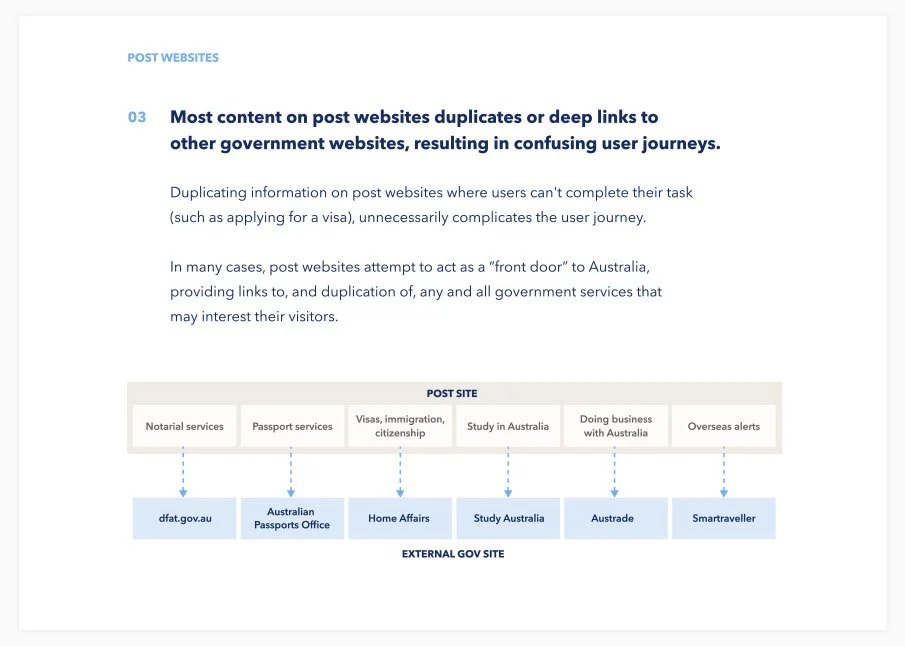Department of Foreign Affairs & Trade (DFAT) Australia
role. research & strategy lead
The Department of Foreign Affairs and Trade (DFAT) manages a vast digital ecosystem, encompassing hundreds of websites that serve Australian citizens and foreign nationals worldwide. These websites currently feature outdated design, inconsistent branding, and fragmented user experiences.
As the research lead at Hide and Seek Digital, I managed the research stream for DFAT’s web redevelopment discovery program, in partnership with content and technology teams. My role covered the entire research scope for dfat.gov.au (the core site) and 109 Australian embassy/consulate websites (post sites) globally.
the business problem
DFAT had very limited knowledge of their website users and the reason people visited the sites. Our discovery work aimed to answer key questions:
1 Who are the primary users of DFAT’s core and post sites?
2 What are their main tasks and needs?
3 How effectively can they complete these tasks on the existing websites?
By addressing these questions, we could define the purpose of each site in DFAT’s ecosystem and provide evidence-based recommendations to improve design, content, and technology.
stakeholder engagement & research planning
To align with DFAT’s goals and existing knowledge, I facilitated two remote stakeholder workshops:
Workshop 1 – focused on dfat.gov.au, engaging stakeholders who manage the core site
Workshop 2 – focused on post sites, engaging stakeholders of embassy/consulate sites worldwide
Recognizing the need for stronger engagement after the first day of workshops, I adapted my facilitation approach to a more interactive style for day two. By pre-filling Miro boards with existing knowledge and encouraging participants to refine or challenge the information, I saw engagement levels significantly increase during the second workshop.
evaluating the current user experience
A critical part of discovery involved assessing the usability, accessibility, and overall experience of DFAT’s sites.
I conducted a UX audit of the DFAT core site and a sample of post sites, identifying several primary usability issues:
navigation & information architecture – complex structures with unclear, non-user friendly language made information hard to find
UI & accessibility – inconsistent design and accessibility barriers gave users no clear signposts and made navigating websites a challenge
content strategy – redundant information with no information hierarchy or content structure
I categorized issues by the severity of their impact on the user experience and provided recommendations for fixing them, equipping DFAT with an actionable list of usability issues to focus on.
recruiting & conducting global user testing
To understand real user experiences, we conducted 19 usability testing sessions across four countries. The challenge? Recruiting participants from diverse user groups, including:
Australian citizens and foreign nationals using dfat.gov.au
Australians abroad and foreign nationals seeking entry to Australia, testing post sites
Due to testing platform limitations, I strategically selected locations (Australia, UK, India, Canada) that could fulfil our participant requirements and designed targeted screeners to ensure diverse representation. The process required careful coordination across time zones, managing cancellations, and rescheduling participants, while ensuring we followed government security and privacy guidelines.
Sessions combined user interviews and task-based usability tests, capturing both qualitative insights and quantitative performance metrics.
synthesizing insights for impact
With 19 interviews and results from a quantitative survey launched across all websites, the research yielded an extensive amount of data to sort through. I managed the synthesis process using Condens, centralizing all research findings for the team to access. Key themes emerged from the research:
Navigation & content findability – complicated user journeys and unintuitive navigation caused users to struggle locating critical information
User journeys & site purpose – websites lack a purpose and sense of identity for Australian citizens and foreigners to connect with
Content duplication & fragmentation – overlapping content across sites caused user confusion when trying to locate information to complete tasks
Lack of cohesive design & outdated technology – contribute directly to a poor, unintuitive user experience that left users confused and abandoning the sites altogether
To communicate these insights effectively, I created personas and journey maps, highlighting key pain points and opportunities for improvement. These artifacts provided DFAT with a clear, human-centered understanding of its diverse user base.
example persona and user journey
influencing strategy with stakeholder buy-in
To ensure our research resulted in strategic action, I led the creation of the executive summary report, synthesizing findings across the research, content, and technology streams. This required:
crafting a clear, concise narrative that would resonate with senior decision-makers.
highlighting top insights & recommendations from a wealth of complex research data in an easily digestible format.
designing the report in Figma for a professional presentation that allowed us to tell the story.
The executive summary became a key deliverable, equipping DFAT leadership with evidence-based insights to inform their next steps.
sample of pages from the executive summary report
impact & outcomes
The research I conducted provided DFAT with its first holistic understanding of global user interactions across its websites, informed by real user insights. Key outcomes from the project included:
executive-level buy-in for a user-centred digital strategy encompassing the entire digital ecosystem.
strategic data-driven recommendations shaping the next phase of web redevelopment.
increased empathy among stakeholders, driven by real user insights in the form of quotes, video clips, and user journeys, presented alongside quantitative data to tell the whole story.
By aligning research insights with business strategy, this project ensured that future improvements to DFAT’s digital ecosystem would be rooted in user needs.






